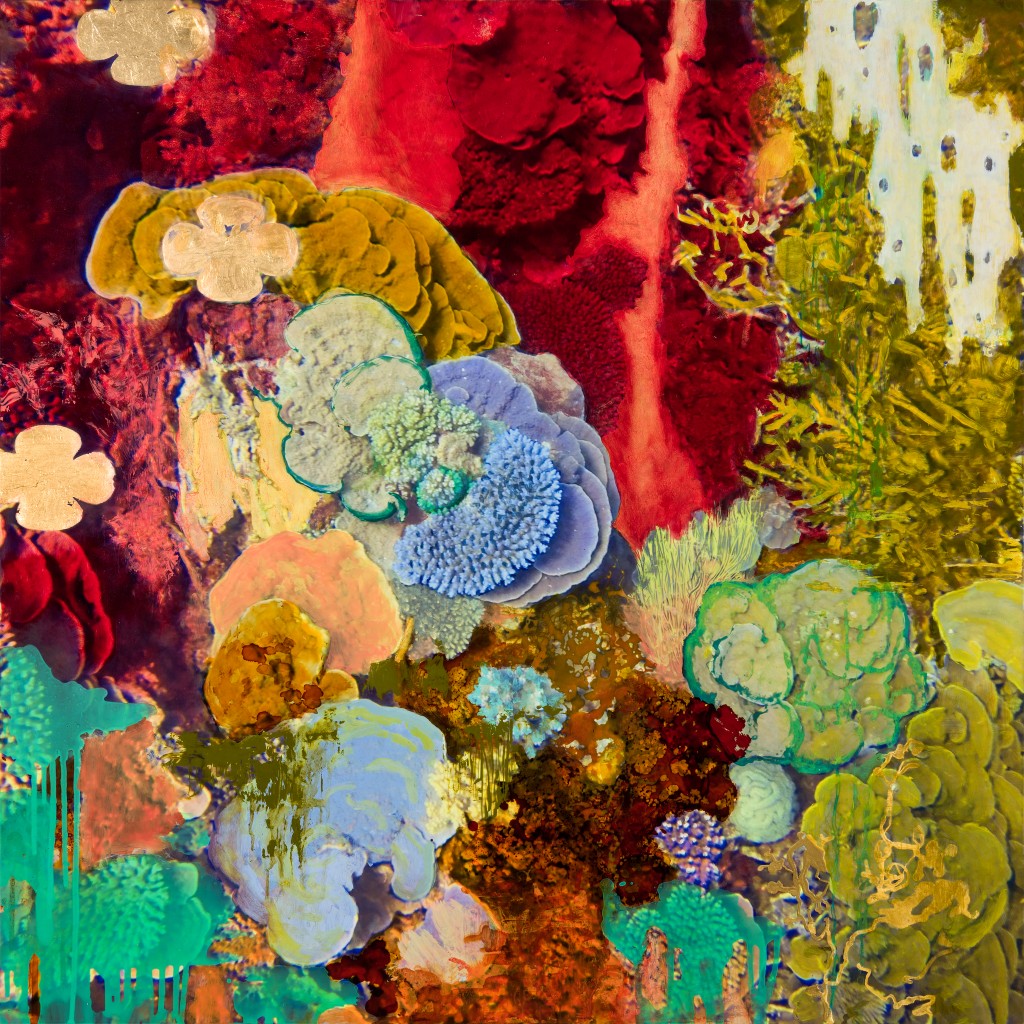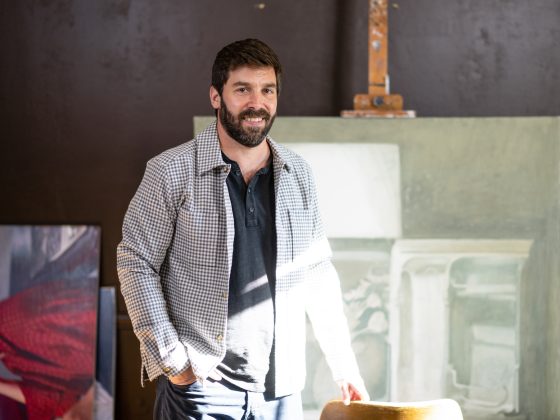Charlotte artist Ruth Ava Lyons paints grand, colorful visions that she says are part of her constant attempt comprehend universal themes of growth, resistance, and adaptation that she sees in both nature and in her own life. She took a few moments away from the studio to answer our questions about her art, her inspiration, and what’s coming up next for the boundary-pushing painter. You can find her work at Hidell Brooks Gallery in Southend.

Where are you from originally?
I was born in Cleveland, and you can definitely spot my blue-collar rust belt accent and demeanor. Directly after graduate school, I leaped into a Fulbright fellowship in Bolivia. When I returned to the states, my partner and I decided to move to Charlotte.
Tell us about the process that got you started with art?
Simple. I felt a need to escape to another world very early on, and the discipline of painting each day started in middle school. Being a “maker” is a calling for some. I feel compelled to speak in the language of paint and to be on this path and some ways I feel I do not have a choice. it’s just something I have to do. The attraction and intensity of burning the fuel of ideas into existence requires a lot of stamina and confidence. I have no idea where that comes from, but making art is definitely an act of faith and comes from turning the deep pockets of your spirit inside out. Artists also gravitate toward a like-minded tribe and mine was composed of misfits who intrigued me with nonconformist ideas. One of these was a tortured and depressed brilliant art teacher whose paintings were romantic, not fashionable, yet singular in vision. He was the one who reminded me to stay true. Another huge influence that kept me in an imaginative state of mind were my weekends in the Cleveland Museum of Art.
Why do you paint, instead of another form of art?
Working with the illusion of the picture plane is a challenge for me. I never felt like it came naturally, so I choose to wrestle it. When magic happens, and things go my way….its like standing under a waterfall. I am interested in the spatial environment that 2D can create and allow the viewer to be immersed in. I generally am not interested in paint that just sits on the canvas to seduce the audience with its physicality or even art for arts sake. I want to speak in this visual language about things I care about. Each artwork I create is like a story as opposed to a page. I am not very prolific and I want each piece to be unique in that it will not look just like the last piece in a river of studio self indulgence that you see artists cranking out these days.
Describe your training – early on, how did you begin to learn about and practice your craft? My parents gave me a lot of pencils and paper when I was in elementary school and I started lessons at the Cleveland Museum Of Art. After undergraduate school, I received my MFA from the prestigious Cranbrook Academy of Art. I learned to think like an artist more than learning technical skills. Being immersed in a creative environment for 2 years really fortifies an artist’s confidence which tends to get eroded by the demands of a culture that doesn’t see art as a significant contribution. But I think my real art education came when I was a Fulbright fellow in South America and traveled solo to places that opened my eyes to nature, architecture, and the many mysteries of the world that travel illuminates.
How and when were you able to get involved with galleries, like Hidell Brooks?
I started showing my work in galleries and institutions in my first years in undergraduate school. I owned a gallery here, Center Of The Earth Gallery, for 24 years. We showed artists from all over the country. When I closed it in 2010, I was very honored to be asked to join the Hidell Brooks stable. They have an excellent roster of artists.
Describe your typical process in the creation of one of your pieces from start to finish.
Since all of my work is inspired by environmental themes, I usually focus on a topic that grabs my attention and I feel a need to interpret. As Picasso says “You have to have an idea of what you are going to do, but it should be a vague idea.” I lay out a composition in my head, but it always evolves during the execution of the art. I put down a wash of color, sit and look at the canvas for a long time, mix colors, and look at the canvas some more before I dive in. The poet Mallarme talked about the fear of the white paper. It is very intimidating to start a relationship with a large blank canvas, so I take it slow. I work in a variety of materials. The only thing I definitely like to explore is the use of glazes, thin washes of layered color that allow light to refract from bottom layers. This effect creates more depth and vivacity and allows me to “play” and experiment to a degree that I may not be sure about the results. That element keeps a sense of adventure to the evolution of the piece.
Who are some of your personal favorite artists? Who or what are your biggest inspirations?
I spend a lot of time researching environmental issues that surface in my work, so I am inspired by the work of biologists and environmentalists who work tirelessly in the field. People like Marjory Stoneman Douglas, who was responsible for the preservation of the Everglades. I did an artist residency there and I was so disappointed to learn how we have damaged this amazing ecosystem. Locally, I respect and adore the work of my partner Paul Sires. He is one of the few sculptors this side of the Mississippi who hand-carves the unforgiving material of granite and if it wasn’t for Paul’s vision, we would not have NoDa. He rescued buildings there and worked tirelessly to put the area on the map for the past 30 years.
Tell us about a project you are working on currently.
I have been collaborating on the 36th street lightrail station project with my partner Paul Sires for the past 7 years. It is slated to open in 2017. Look for a life-size smalti glass mosaic mural of a stylized lotus at its entrance.
What’s next for you, and where can people find out more about your work?
I hope to be on a liveaboard in Micronesia this summer for an underwater photography workshop funded by a grant. I am also pursuing a residency in the Amazon basin. I am solidifying plans for the exhibition of my Monarch Butterfly Sightings Migration series and the Oceanic Alchemies series to be shown at a research institution, a natural history museum, and galleries in 2017-18. My work can always be viewed in Charlotte at Hidell Brooks Gallery in Southend and, of course, my website: www.ruthavalyons.com or hidellbrooks.com












